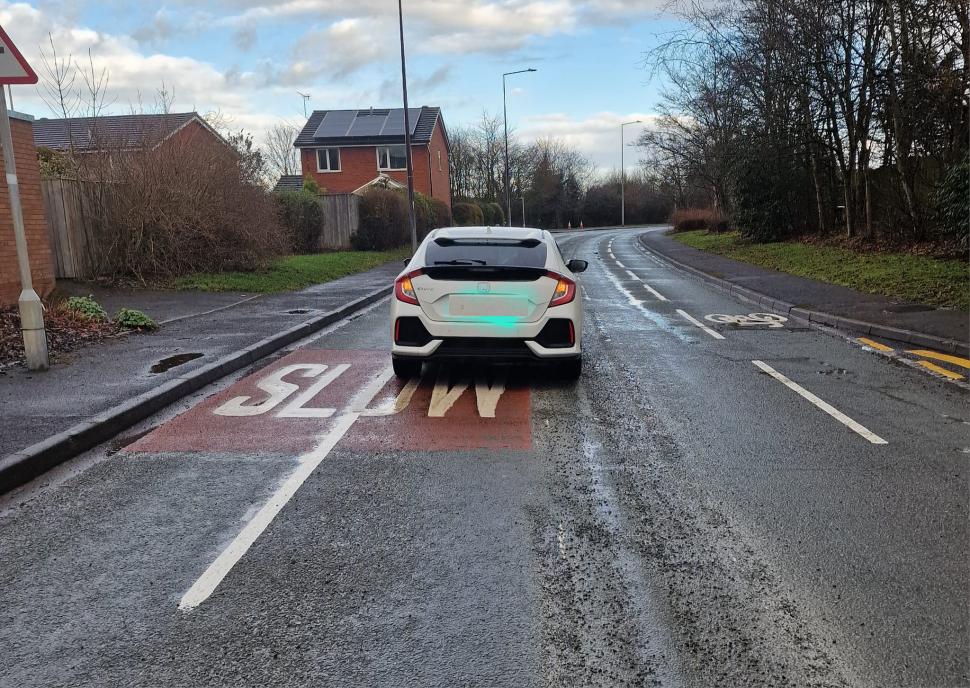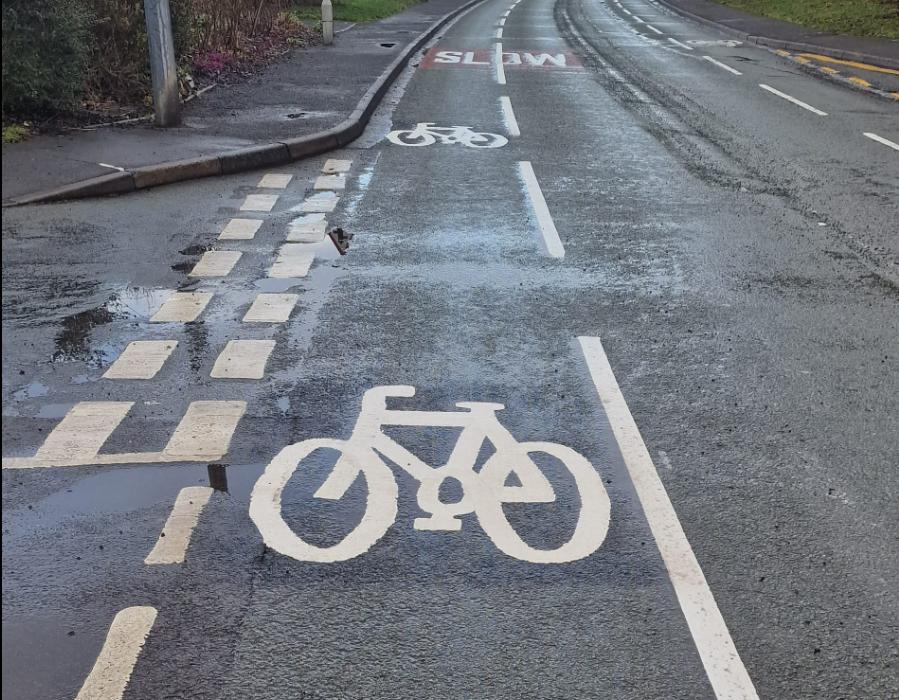- News
- Reviews
- Bikes
- Accessories
- Accessories - misc
- Computer mounts
- Bags
- Bar ends
- Bike bags & cases
- Bottle cages
- Bottles
- Cameras
- Car racks
- Child seats
- Computers
- Glasses
- GPS units
- Helmets
- Lights - front
- Lights - rear
- Lights - sets
- Locks
- Mirrors
- Mudguards
- Racks
- Pumps & CO2 inflators
- Puncture kits
- Reflectives
- Smart watches
- Stands and racks
- Trailers
- Clothing
- Components
- Bar tape & grips
- Bottom brackets
- Brake & gear cables
- Brake & STI levers
- Brake pads & spares
- Brakes
- Cassettes & freewheels
- Chains
- Chainsets & chainrings
- Derailleurs - front
- Derailleurs - rear
- Forks
- Gear levers & shifters
- Groupsets
- Handlebars & extensions
- Headsets
- Hubs
- Inner tubes
- Pedals
- Quick releases & skewers
- Saddles
- Seatposts
- Stems
- Wheels
- Tyres
- Health, fitness and nutrition
- Tools and workshop
- Miscellaneous
- Buyers Guides
- Features
- Forum
- Recommends
- Podcast
news
 'Unsafe' cycle lanes in Telford removed days after being introduced (credit - Steve Coleman)
'Unsafe' cycle lanes in Telford removed days after being introduced (credit - Steve Coleman)“Ridiculous” and “unsafe” advisory cycle lanes removed just days after being introduced by council to reduce speeds
A council has been forced to remove painted advisory cycle lanes on a road notorious for speeding motorists just days after they were installed, following complaints from locals that the new lanes were “unsafe” and made the carriageway “too narrow” for drivers to safely pass.
Telford and Wrekin Council introduced the advisory cycle lanes on Bellpit Road and Colliers Way, The Rock, Telford, at the end of February, as part of measures designed to prevent motorists from “speeding at dangerously high levels” in the area.
However, according to the Shropshire Star, the lanes – marked with a broken white line, which allows motorists to enter them – were quickly criticised by local residents, who complained to the council that the new layout was confusing and potentially dangerous.
> Painted advisory cycle lanes increase risk of cyclist casualties, study finds
One local, Steve Coleman, claimed that he witnessed a near miss between two motorists on Bellpit Road and that the new cycle lanes ensured that “there is not enough room for two cars to pass safely”.
“I agree with safety measures, speed bumps etc, but come on, the road is too narrow for what they have done,” Coleman, who appeared unaware that motorists can, in fact, enter the advisory lanes if safe to do so, said on Facebook.
Another resident wrote: “I drove up there thinking they turned it into a one-way system, so I was driving in the middle of the road, avoiding going into the cycle lane, to then seeing another car coming down in the middle of the road. It’s ridiculous.”
Following these complaints, Telford and Wrekin Council swiftly removed the lanes at the weekend, with the local authority announcing that it will now a pursue “a more commonly known solution” – such as a new 20mph limit – to help curb the area’s speeding issue.
“Residents in The Rock along with the parish council asked Telford and Wrekin Council to help reduce traffic speeds across the area,” a spokesperson for the council said.
“The council has a duty to provide safe highways for all users and monitoring has clearly showed vehicles speeding at dangerously high levels on Bellpit Road and Colliers Way in particular.
“Following two rounds of consultation with residents, further views were raised regarding the new road layout underway at The Rock for which the council is thankful.
“We have listened and acted upon these comments where appropriate and amendments have been made. We will now continue to work towards reducing traffic speeds and implementing a 20mph zone.
“This will be achieved by a more commonly known solution in the borough with new centre and edge of carriageway lines as well as speed indicator devices. The project continues to stay within the approved budget.”
Telford and Wrekin Council’s hasty U-turn follows a similarly abrupt change in cycle lane policy in Edinburgh, where last week the city council voted to reinstate bollards on a busy bike lane just weeks after they were taken away.
In September, the City of Edinburgh Council agreed to remove the bollards on Drum Brae North due to safety concerns for cyclists “at risk when coming downhill on the steepest section of the hill”.
Councillors claimed that people using the segregated cycle lane, installed during the Covid-19 pandemic as part of the city’s Spaces for People scheme, were in danger of colliding with the bollards if forced to take “evasive action such as if someone was reversing from a driveway”.
However, since the bollards were removed in January, images and videos flooded social media showing drivers treating the cycle lane like another lane of motor traffic, forcing councillors to criticise the “depressing lawlessness” of these bike lane-using motorists and prompting the swift reinstalment of the bollards along half of the cycleway.
Ryan joined road.cc in December 2021 and since then has kept the site’s readers and listeners informed and enthralled (well at least occasionally) on news, the live blog, and the road.cc Podcast. After boarding a wrong bus at the world championships and ruining a good pair of jeans at the cyclocross, he now serves as road.cc’s senior news writer. Before his foray into cycling journalism, he wallowed in the equally pitiless world of academia, where he wrote a book about Victorian politics and droned on about cycling and bikes to classes of bored students (while taking every chance he could get to talk about cycling in print or on the radio). He can be found riding his bike very slowly around the narrow, scenic country lanes of Co. Down.
Latest Comments
- cyclisto 7 min 12 sec ago
Agreed, most bikes are too low for most of users. There are solutions (17 or 30 degree stems, even steerer tube extensions), but they are not the...
- hawkinspeter 1 hour 27 min ago
Seems to me that if the traffic is too dangerous to police, then that road needs to be closed to motor traffic.
- David9694 1 hour 28 min ago
Opinion: Making people pay to use car park is making the roads cluttered...
- perce 1 hour 29 min ago
That's better - much more concise. Well done.
- henryb 1 hour 56 min ago
I think you've just hit on the unexploited use case for these sensors, although I'd suggest the cadence sensor would be a better one to start with ...
- Rendel Harris 4 hours 5 min ago
He had major wins at the Tour of the Basque Country and Tour of California, plus top tens in the Tour de France, World Championship Road Race, Tour...
- john_smith 11 hours 1 min ago
Funny world you inhabit. If I discovered someone camping on my land and I had a problem with it, I'd politely ask him to leave. No unmannerliness...
- azbikelaw 12 hours 8 min ago
All the felonies all also have one, even more, important problem; they all involve proving a mental state, e.g. assault is something done ...
- Rendel Harris 12 hours 43 min ago
See below from the TfL website. £31- £39 and "may be higher if there are delays or heavy traffic", tell me a time in London at rush hour there...

Add new comment
35 comments
Apparently those are not cycle lanes on the Dutch roads, it's just done to make the road look narrower, to slow drivers down. They don't paint cycle symbols in the margins.
These roads also tend to be minor routes, i.e. there's a bigger road nearby that runs parallel, or they are non-through routes for motor vehicles so are taking local traffic only.
As usual, we get it so wrong in the UK and just slap down some lines because it looks the same, without doing all the other stuff that makes it work. Even so, I think these are being phased out in the Netherlands for segregated infrastructure where possible, as some drivers do think they are cycle lanes.
https://www.aviewfromthecyclepath.com/2009/07/country-road.html
Amen. Bicycle Dutch as usual has a good article / video on this subject too:
https://bicycledutch.wordpress.com/2020/08/12/cycle-lanes-in-the-netherl...
Again a key point which often seems to be missed in UK vs NL provision is that there are normally fairly low limits on both the numbers AND speed of motor vehicles wherever certain types of infra - which involve mixing or even just crossing of modes - are used.
As others have alluded to, in the UK we have unrealistically high expectations of what we can achieve using unrealistically small amounts of money. We hope that minimal physical changes will work magic - wands, we believe it seems, signs and paint have the power to change behaviour when there are thousands of drivers taking a route a the busiest times.
Cart before horse - if we've too many drivers going too fast that is the problem. *That* needs fixed before you can hope many cyclists would brave the area.
And these people have passed a test to allow them the privilege of driving on our roads?
If ever there was evidence required to sum up the ineptness of the typical motorist, the comments above should be noted.
Perhaps it's time for mandatory re-testing for drivers, as judging by those comments none of them even knew relatively basic knowledge of the Highway Code.
So the council's strategy to combat dangerous speeding was to slap a chunk of painted cycle lane in the middle of the road, in an area notorious for dangerous driving. In other words, use cyclists as speed bumps in the front of motorists who drive without due care and attention for other vulnerable road users...? So basically do exactly the worst possible thing you can that will increase likelihood of a collision.
Motorists who drive dangerously and flout road rules don't care about the safety of other road users, so positioning vulnerable road users in front of them is just going to get someone killed. Selfish people only care about what affects them. Average speed cameras and police checks would be a more effective solution.
It truly is amazing how almost every single cycle infrastructure scheme in this country manages to be so unbelievably poor in its planning and function. It's truly remarkable. Nearly all the issues are obvious, too. It's so frustrating.
And there seem to be so many wrong ways that councils get it wrong - it's almost like none of them know that there are guidelines to help them do the right thing...
https://www.gov.uk/government/publications/cycle-infrastructure-design-l...
Pages